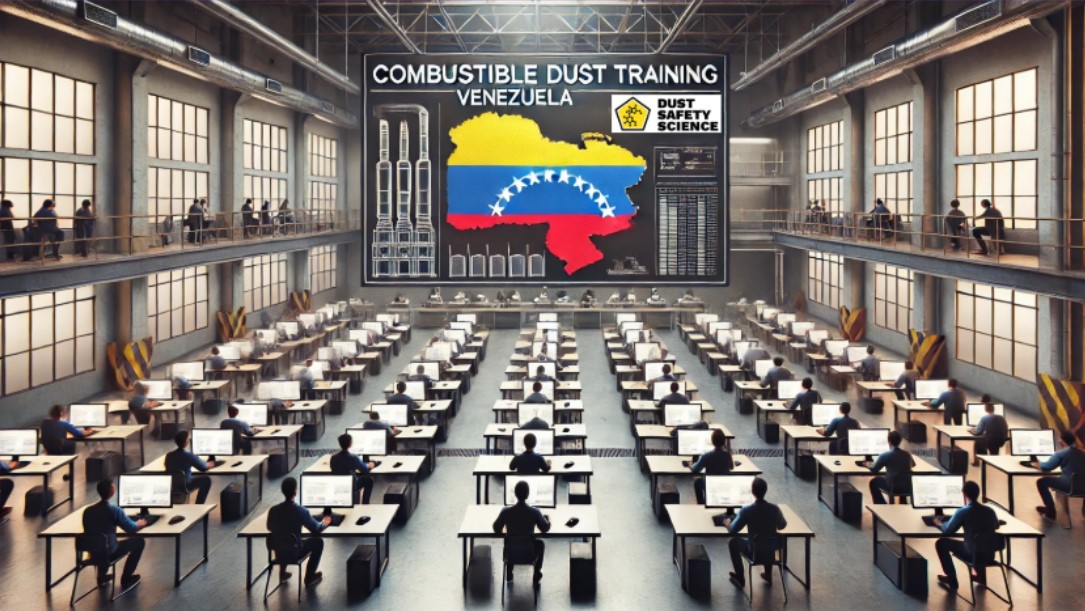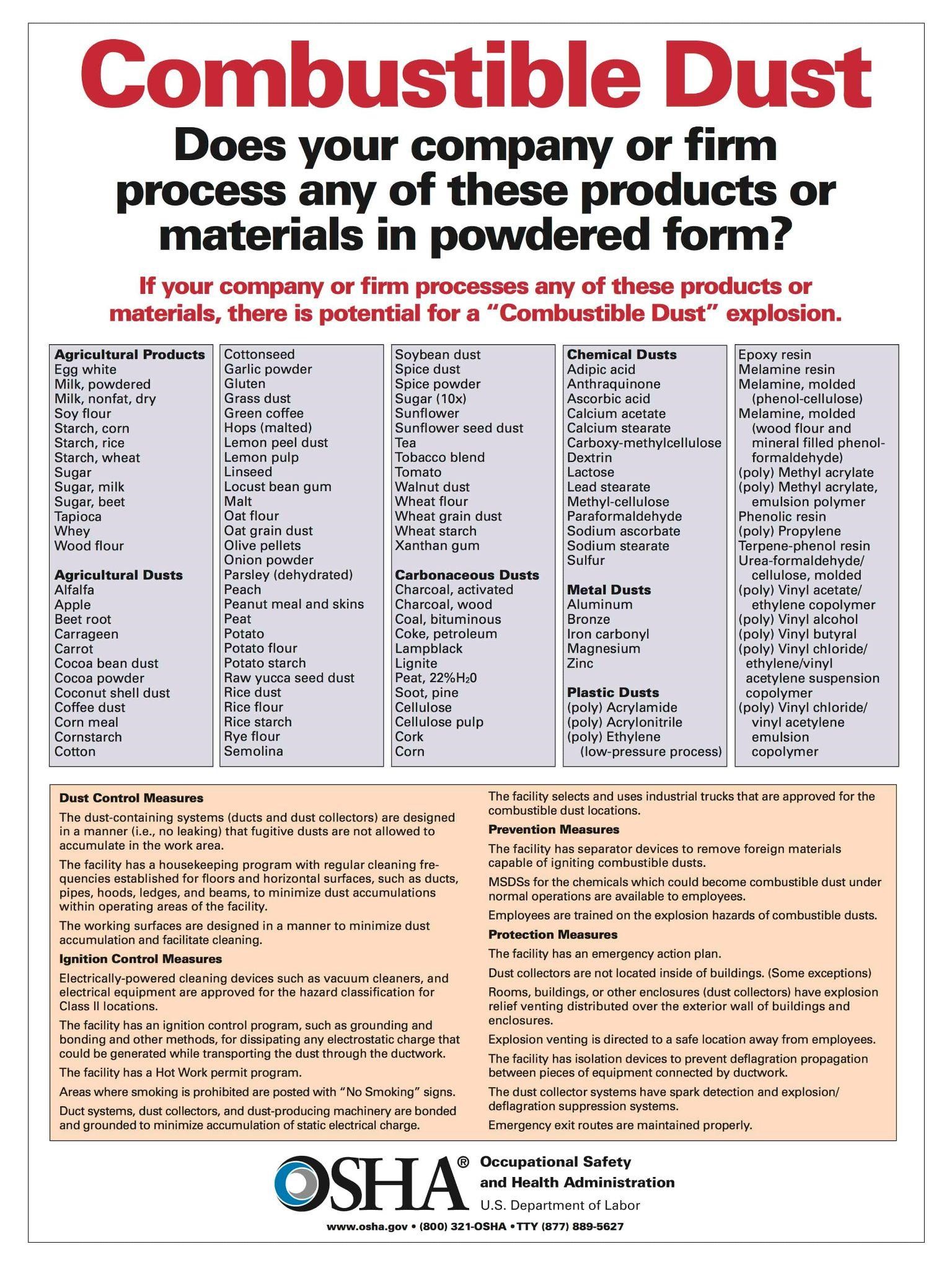Published January 8, 2025 Authored by Dr. Chris Cloney and Jon Barrett of Dust Safety Science

Prevent Dust Explosions in Venezuela with Expert Training: Protect Lives and Reduce Risks
Dust explosions pose a critical safety risk in various industries worldwide, including Venezuela. Industries such as agriculture, food processing, mining, and manufacturing are particularly vulnerable to these hazards due to the abundance of combustible materials and the lack of stringent safety measures. Past and present dust explosions in Latin America highlight the pressing need for comprehensive safety protocols and combustible dust training to mitigate risks effectively. Some of the countries in South America and Latin America affected by combustible dust explosions include: Venezuela, Mexico, Brazil, Argentina, Peru, Colombia, Bolivia, Costa Rica, Panama, Puerto Rico, Chile, Paraguay, Ecuador, Guyana, Uruguay, Suriname, French Guiana, the Falkland Islands (UK), Belize, El Salvador, Guatemala, Honduras, Nicaragua, Cuba, Dominican Republic, Haiti, Guadeloupe, Martinique, Saint-Barthélemy, and Saint-Martin.
One of the most effective methods for addressing combustible dust hazards is Dust Hazard Analysis, (DHA). A DHA is a proactive measure to identify potential risks and implement controls to prevent dust explosions. This article explores the importance of dust explosion safety in Latin America, provides an overview of DHA, and emphasizes the need for targeted training programs to enhance industrial safety. Beyond the tragic loss of life, dust explosions can cause extensive property damage, production downtime, and financial setbacks. Combustible dust, produced in manufacturing operations, can ignite under the right conditions, leading to explosions with catastrophic consequences.
Every year, combustible dust explosions and incidents happen across all manufacturing industries, causing widespread destruction, injuries, and even loss of life. The financial toll is staggering, with billions in property damage and legal costs. Despite the risks, many industrial facilities and manufacturing plants must tackle the challenges of combustible dust.
The question is: Are you doing enough to protect your business and employees from dust explosions? To create a safer workplace, visit Latin America Dust Explosion Safety and Dust Hazard Analysis Demystified Online Training.
The Devastating Consequences of Dust Explosions
Combustible dust incidents don’t just cause physical damage—they devastate lives. Workers face injuries or fatalities, businesses lose productivity, and the aftermath often leads to reputational damage and regulatory fines. To address this hidden threat, proactive safety measures are essential. Enter Latin America Dust Explosion Safety and Dust Hazard Analysis Demystified Online Training a game changer in industrial safety.
Combustible Dust Safety Training: A Necessary Defense
Safety training empowers businesses to identify, control, and mitigate combustible dust hazards. A well-structured training program ensures compliance with standards, enhances workplace safety, and promotes operational efficiency.
To take the first step toward creating a safer workplace, visit Latin America Dust Explosion Safety and Dust Hazard Analysis Demystified Online Training. The training solutions equip organizations to handle combustible dust risks effectively.
Understanding Combustible Dust Explosions
What is Combustible Dust?
Combustible dust is made of fine particulate solids that can ignite and explode when dispersed in the air. These particles, ranging from flour, coal, and wood to powdered metals, form an explosive mix when conditions are optimum.
The Dust Explosion Pentagon identifies five critical elements required for a dust explosion:
-
Fuel: Combustible dust.
-
Oxygen: Present in the air.
-
Ignition Source: Heat, sparks, or flames.
-
Dispersion: Particles suspended in air.
-
Confinement: Enclosed spaces that amplify explosive force.
When all five elements converge, the results can be catastrophic.
Common Causes of Dust Explosions in Venezuela
-
Overheated Bearings: Inadequately maintained equipment is a frequent ignition source.
-
Electrical Failures: Faulty wiring, static electricity, or faulty equipment can lead to sparks.
-
Flames: Open flames, cigarettes and cigarette butts, matches, and lighters.
-
Dust Accumulation: Poor housekeeping allows dust to collect and become a serious hazard.
-
Mechanical Malfunctions: Equipment failures can generate heat and friction, igniting dust clouds.
Industries at Risk of Combustible Dust Explosions
Venezuela’s top crops are coffee, sugarcane, corn(maize), and rice. According to the Observatory of Economic Complexity, (OEC), the top exports of Venezuela are Scrap Iron, Petroleum Coke, Crude Petroleum, Acyclic alcohol derivatives (halogenated, sulphonated, nitrated), and Raw Aluminium. According to the Observatory of Economic Complexity, (OEC), acyclic alcohol derivatives are primarily sourced from the fermentation of sugars and other carbohydrates, most commonly using sources like corn, grains, molasses, and sugar, where yeast converts the sugars into ethanol (simple acyclic alcohol) which can then be further processed to produce other acyclic alcohol derivatives depending on the desired application; fossil fuels can also be a source for certain acyclic alcohols through chemical processes. All of these products and bulk materials can generate combustible dust.
While combustible dust hazards exist in many industries, some industries are more prone to combustible dust explosions than others:
-
Food Processing: Soybean, flour, coffee, rice, cotton, beans, cacao, wheat, cocoa, sugar, corn, maize, nuts, and grain dust.
-
Woodworking: Sawdust and fine wood particles.
-
Pharmaceuticals: Fine powders, plastics, and chemicals.
-
Biomass: Wood, wood residues, tobacco, energy crops, agricultural residues. including straw, peat, and organic waste from industry and households.
-
Coal: Coal Mines, coal dust, and Coking coal dust.
-
Fireworks: Metallic fine dust such as Aluminum, magnesium, titanium, zinc, iron filings, strontium and barium salts
-
Metalworking: Aluminum, magnesium, zirconium, and other metallic dust.
Coal mines and coal dust continue to be problematic creating combustible dust explosions. Several research studies focus on coal and spontaneous combustion, creating possible dust explosions:
-
Study of Spontaneous Combustion of Coal during Stockpiling at the El Hatillo Mine, located in Cesar, Colombia
-
Spontaneous combustion of the Upper Paleocene Cerrejón Formation coal and generation of clinker in La Guajira Peninsula (Caribbean Region of Colombia)
Each industry requires customized training to manage unique risks. Learn how tailored training can address these challenges by visiting Latin America Dust Explosion Safety and Dust Hazard Analysis Demystified Online Training Dust Safety Science’s Training Page.
Historical Dust Explosion Prevalence in Venezuela
Dust explosions are not limited to any single region or industry, however, South America and Latin America have seen notable incidents over recent decades, emphasizing the need for targeted prevention. According to global data, approximately 200–300 dust explosions are reported yearly across various industries. While Latin America lacks comprehensive regional statistics, individual cases highlight the seriousness of this hazard.
While there are no specific documented incidents of combustible dust explosions in Venezuela, the country is noted for its industrial activities that may present risks for dust explosions.
According to NASA Earth Observatory, In March 2024, extensive fires were observed in Venezuela, likely exacerbated by environmental factors such as prolonged dry weather due to climate patterns like El Niño. These conditions indicate an environment where spontaneous combustion could be possible if combustible dust is present, particularly in industrial sectors. The potential for incidents exists, especially in agriculture and manufacturing sectors where dust is prevalent. Ongoing research and improved safety standards remain vital to preventing tragedies associated with combustible dust in the region.
Notable Case Studies in South America and Latin America:
-
April 5, 2020: Eleven Killed and Four Injured in Colombian Coal Mine Explosion, in Cucunubá, Cundinamarca Colombia.
-
March 14, 2023: Twenty-One Miners Killed in Devastating Coal Mine Explosion in Sutatausa, Cundinamarca Colombia.
-
May 2024: Fireworks Factory Explosion in Colombia Leaves 1 Dead;
-
August 1956: Seven trucks from the Colombian National Army, carrying more than 40 tons of dynamite, exploded. The explosion killed more than 1,000 people and left a crater 25 metres (82 ft) deep and 60 metres (200 ft) in diameter.
-
May 2019: Four dead, 29 injured in Colombian Gunpowder factory explosion
-
Mexico, 2010: An explosion at a food processing facility in the state of Jalisco, the Jose Cuervo tequila factory, including agave, the key ingredient in tequila, resulted in significant injuries and production losses, bringing to light the need for improved safety standards in food processing.
-
According to the Border Report, an explosion at a home that stored gunpowder for fireworks left two people dead, three people were injured, and damaged dozens of homes and cars in Reynosa, Mexico, in September 2024.
-
According to Powder & Bulk Solids, an explosion occurred at the Jose Cuervo tequila distillery in Tequila, Jalisco state in Mexico, killing 5 people, in July 2024.
-
According to Wikipedia, in December 2016, a firework explosion occurred at the San Pablito Market in the city of Tultepec, north of the Valley of Mexico, and at least 36 people died.
-
Argentina, 2019: An explosion at a grain silo, involving cereal, in Rosario emphasized the risks associated with poor dust management in agriculture.
-
One of the most recent and tragic incidents occurred at a feed factory in Jaguapitã, Paraná, where an explosion resulted in the loss of one worker’s life and severe injuries to two others. While the exact cause of the explosion is still under investigation, initial reports suggest that combustible dust may have played a significant role.
-
In another recent incident, at least eight people were killed and nearly a dozen were injured after a grain silo explosion in the city of Palotina, Parana State, Brazil, occurred on July 27, 2023. The silo where the explosion occurred stored about 12,000 metric tons of soybeans and 40,000 metric tons of corn.
-
A previous combustible dust explosion, Two Workers Injured When Welding Spark Ignites Dust Explosion in Brazil, in November 2022. At the time of the explosion, the two workers were welding on some metal structures. It is believed that a welding machine spark ignited the explosion.
-
Per research from Roberto D. Hajnal, and published on OpenAgrar, several Grain terminal and grain storage explosions have occurred in Brazil and Argentina over the past decades.
-
An additional source of a combustible dust incident in Brazil includes Silo Blast in Southern Brazil Kills at Least Eight, One Missing.
Combustible dust incidents, continue to occur worldwide and in many industries, as presented in this combustible dust research and incident database from Dust Safety Science. Over 120 combustible dust incidents have occurred just in the last 5 years, in Brazil alone.
Why Combustible Dust Safety Training is Crucial in Venezuela
Regulatory Compliance
In Venezuela, the main law on occupational safety and health in Venezuela is the Organic Law on Prevention, Working Conditions and Working Environment, (LOPCYMAT), which was adopted in 2005.
In addition, the Venezuelan Commission for Industrial Standards (COVENIN) has established standards on a variety of OSH issues. These regulations address issues such as work in confined spaces, fire risks, personal protective equipment, maximum temperatures in workplaces, and records, classification, and statistics regarding occupational injuries.
According to the USDA Foreign Agricultural Service, in general, packaging and container regulations are enforced by SENCAMER, based on COVENIN established standards and norms, but in some cases, the Codex Alimentarius guidelines apply. New manufacturing, storage, and transportation practices for foods for human consumption were established by MINSALUD through Official Gazette Nº 38,739, dated August 5, 2007 (which replaced the norms of Official Gazette Nº 36,081, dated November 7, 1996).
Regulatory agencies like OSHA and standards like NFPA 652 mandate measures to control combustible dust risks. Failure to comply not only endangers lives but also leads to penalties. Training helps organizations stay compliant and avoid legal consequences.
In addition, NFPA 61, Standard for the Prevention of Fires and Dust Explosions in Agricultural and Food Processing Facilities, protects lives and property from fires and explosions in wheat facilities handling, processing, or storing bulk agricultural materials, their by-products, or other agricultural-related dust and materials.
Risk Mitigation
Identifying and mitigating dust hazards is central to a safe work environment. Training programs, such as those offered by Dust Safety Science, provide actionable insights to reduce risks through Dust Hazard Analyses (DHA) and preventive strategies.
Employee Safety
Education is key to empowering workers. Through training, employees learn to:
-
Recognize Combustible Dust Hazards.
-
Use properly rated, Combustible Dust Control Equipment, such as Dust Collectors, Dust Control Fans, and Combustible Dust rated Vacuums.
-
Use personal protective equipment (PPE) effectively.
-
Follow emergency procedures during incidents.
Operational Efficiency
Preventing explosions reduces downtime, maintains productivity, and saves costs associated with accidents. Proper training ensures smoother operations and a safer workplace.
Core Elements of Combustible Dust Safety Training
Dust Hazard Analysis (DHA)
A Dust Hazard Analysis, DHA, is the cornerstone of dust safety. A Dust Hazard Analysis involves identifying hazardous zones, evaluating risk severity, and implementing control measures. Training ensures participants can conduct effective DHAs for their facilities.
Housekeeping and Maintenance
Dust accumulation poses a significant risk. Training covers:
-
Effective cleaning techniques to minimize airborne dust.
-
Preventive maintenance schedules for equipment.
-
Targeting hard-to-clean areas where dust tends to settle.
Ventilation and Dust Collection
Proper ventilation and dust collection are critical to control dust at its source. Training addresses:
-
Designing effective dust collection systems.
-
Ensuring ongoing system inspections and maintenance.
-
Educating staff on the proper use of dust collection equipment.
Ignition Source Control
Ignition sources are often preventable. Training programs focus on:
-
Identifying ignition risks, such as open flames, hot surfaces, and electrical faults.
-
Implementing spark detection and suppression systems.
-
Using explosion-proof equipment in high-risk areas.
Emergency Response Planning
When an incident occurs, preparedness can save lives. Training equips workers with:
-
Evacuation procedures and drills.
-
Fire suppression strategies.
-
First aid skills to handle injuries effectively.
Invest in these essential safety components by enrolling in Latin America Dust Explosion Safety and Dust Hazard Analysis Demystified Online Training
Why Choose Dust Safety Science for Dust Explosion Training in Venezuela?
Comprehensive Curriculum
The Latin America Dust Explosion training program delves deep into every aspect of combustible dust safety, from understanding explosion mechanics to fundamentals of dust fire and explosion safety and dust hazard analysis. Learn more at Latin America Dust Explosion Safety and Dust Hazard Analysis Demystified Online Training
Expert Instructors
With a team of seasoned professionals, Dust Safety Science brings unparalleled expertise. Their instructors ensure participants receive actionable, industry-specific guidance.
Flexible Training Options
Choose a format that fits your needs:
-
Online Courses: Flexible and accessible.
-
In-Person Training: Hands-on experience for practical learning.
-
Hybrid Options: A blend of convenience and interactivity.
Customized Training Solutions
Every industry faces unique challenges. Dust Safety Science offers tailored training solutions, that address specific risks and compliance needs. Start customizing your training today by visiting Dust Safety Science’s Training Page.
Take Action: Ensure Your Facility’s Safety Today
Combustible dust is an invisible threat with potentially devastating consequences. Comprehensive safety training is not optional, it’s a necessity. Protect your workforce, reduce risks, and ensure regulatory compliance by investing in professional training.
Start your journey toward a safer workplace today by enrolling in Latin America Dust Explosion Safety and Dust Hazard Analysis Demystified Online Training. Learn more about their programs and how they can benefit your organization.
Don’t wait until it’s too late. Visit Latin America Dust Explosion Safety and Dust Hazard Analysis Demystified Online Training now to secure your facility’s future.

About Dust Safety Science
Dr. Chris Cloney, of Dust Safety Science, provides additional Combustible Dust Incidents in Latin America, with a Podcast. Click on these Podcast Links: Combustible Dust Safety in Brazil and 2020 Conference Review with Monica Remonato and Dust Explosion Prevention and Protection in Brazil with Jay Juvenal

Resources:
Visit: Latin America Dust Explosion Safety and Dust Hazard Analysis Demystified Online Training
Visit: Dust Safety Science’s Training Page
Visit: Fire and Explosion Protection Equipment Providers
Visit: Risk Assessment & Dust Hazard Analysis Providers
Visit: Combustible Dust Testing Providers
Visit Dust Safety Science (Global Incident Tracking)
Visit Dust Safety Academy (Resources, Training, and Events)
Visit Dust Safety Professionals (Need Help? Get Support Today!)
Visit Dust Safety Journal for the Dust Safety Science Monthly Journal
Subscribe to our FREE, Dust Safety Science Newsletter at Dust Safety Science Newsletter
Visit the Dust Safety Science blog for written articles on combustible dust safety including the latest research, expert opinions, and state-of-the art in fire and explosion protection.
